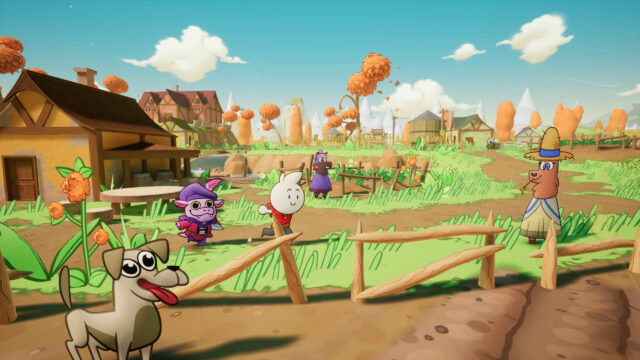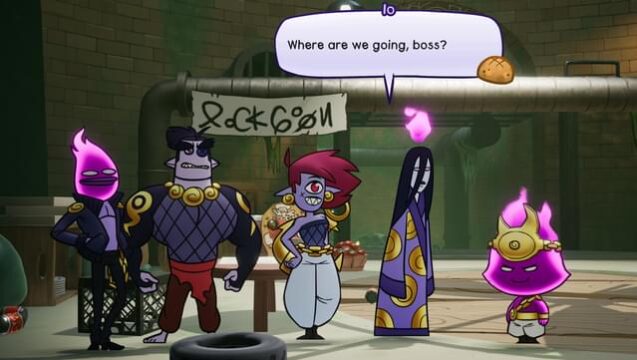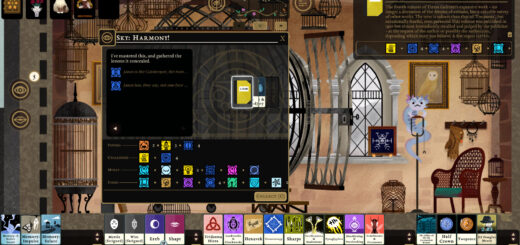Born of Bread Review
Mostly Proofed and Rising to the Occasion
Over the years, RPG protagonists have come in all shapes and sizes, from various backgrounds, walks of life, and upbringings. However, it’s safe to say that developer WildArts has tapped into uncharted territory when coming up with the hero and general premise of its turn-based comedy adventure Born of Bread. The game stars Loaf, a sentient anthropomorphic, well, loaf of bread come to life when the kingdom’s royal baker tried a new recipe he found in a mysterious magical tome. If this setup doesn’t make it sufficiently clear, Born of Bread is a wildly inventive, charming, and laugh-out-loud funny game with a colorful cast and gorgeous world to explore. Unfortunately, its Paper Mario-inspired combat system quickly becomes such a repetitive chore that it markedly detracts from the overall experience.
Born of Bread‘s narrative focus is far more on the journey than the destination, yet a catalyst to kick off the proceedings is still provided. Enter Jester, a flame-headed demon princeling and the game’s primary antagonist. Along with a small entourage of his closest friends, Jester hails from a kingdom from ages past that has since fallen into obscurity and been completely built over. Lost in time and inexplicably rematerializing on the very same night that Loaf is cooked up, Jester and his crew make it their mission to acquire the powerful Sunstone Shards, with which they plan to summon forth their own fallen kingdom to rule over all the land. As Loaf, it is up to the player to foil Jester’s attempts at nabbing the scattered Sunstone Shards (and recruit some helpful allies along the way).
It helps that the world is a fun one to explore, with three or four distinct main zones surrounding the castle town hub area. Each main zone has some smaller annex areas, as well as a dungeon that will eventually have to be completed. The world is vibrantly colorful and rife with NPCs, sidequests, and hidden secrets to uncover. Oftentimes, accessing these off-the-beaten-path secrets requires the use of one of Loaf’s companions’ exploration abilities; for example, Lint the raccoon is able to dig up certain mounds of dirt to unearth buried goodies, while the llama-like Yagi can materialize certain platforms using his powers of meditation. Loaf will meet four playable party members over the course of the fifteen-to-twenty-hour adventure, all of whom add a lot of spice and humor to the storytelling.
Born of Bread overall manages something that’s often elusive in games: it is genuinely, charmingly funny. This is evident in nearly every facet of the game, like the interactions between not just party members but NPCs as well, sharp-witted writing that isn’t above well-intentioned puns (“Bake it till you make it”, “By Barnabas’ non-stick spatula!”), and hilarious character animations that weave together great comedic timing and goofy sound effects in the best of ways. It’s a world that’s a joy to explore and spend time in. The adventurer’s guild features a workspace where office drones with names like Jim, Michael, and Dwight busily type up sidequest scripts; the Buddhist mountaintop temple hosts an annual fighting tournament, during which the otherwise peaceful slimes who live there occasionally fail to hide their barely suppressed lust for bloodsport; and a tour bus regularly visits the medieval castle town to shuttle tourists to the nearby winter zone where they can gaze at the northern lights.
It’s also easy on both the eyes and ears. Apart from the very pleasant saturation of color everywhere one looks, the environments have a unique, stylized aesthetic that’s both detailed and somehow hyper-realistic, at once very different from the characters who inhabit them while somehow managing to mesh well together. Environments can often look quite cartoony, whereas certain areas, primarily indoors, feature a more realistic art style; rather than clash, the two styles somehow manage to complement each other. The final cherry on top of the exploration sundae is the lighthearted and jaunty soundtrack, full of earwormy compositions begging to hum along with. It’s a soundtrack that would feel right at home in a Zelda game, and adds immensely to the good vibes during the time spent exploring.
Unfortunately, the other main aspect of gameplay players will spend most of their time in — combat — is far less of a positive experience. Born of Bread takes more than a handful of pages out of Paper Mario‘s playbook here, and as such mileage may vary for those who enjoy the battle systems of the plumber’s RPG outings. Battles are turn-based, governed by unseen readiness stats that determine in which order Loaf and his foes will trade blows. Loaf himself does not learn new combat skills during the adventure; rather, his attacks are determined by the weapons equipped to his weapon grid. Each attack must be executed by completing a short QTE event (pushing buttons in a certain sequence, pressing a button for a precise amount of time, etc.) that determines how successful the attack is, or whether it perhaps misses altogether.
Each weapon has a different shape and takes up various amounts of space on the grid, though it is possible to enlarge the grid as the game goes on. Attaining new weapons is therefore not necessarily an automatic combat boost, as equipping a new one typically means losing the utility of others. Using a weapon’s skill may also eat up relatively sizeable amounts of Will Points (the game’s take on MP), and each weapon has a specific affinity which enemies may be strong against or susceptible to. It is therefore just as likely to find oneself able to take out enemies efficiently as to face a mob wholly unprepared, and switching out weapons mid-battle is not an option. Neither is swapping party members, and since only one of them can accompany Loaf into battle, it’s easy to get stuck with one who’s innate weapon type affinity is a detriment rather than a boon in any given situation. Exploration segments likewise only allow for one ally to be used at a time, but there they can be quickly cycled through with the push of a button, while combat locks them in until the battle’s end. While both combatants have their own health points, Will and Resolve Points used for abilities and other special attacks are shared, and it’s an automatic game over should Loaf kick the bucket.
Just like in Paper Mario, damage numbers are miniscule: an average attack may only do between one and three points of damage, and the only way to deal (marginally) more is with better weapons. Still, engaging in combat and leveling up is important as it’s the only way to increase aspects like Loaf’s HP and the limited inventory size. Loaf’s allies, however, only grow stronger through the distribution of skill points, which are awarded for finding hidden lizards during world exploration, and focusing on building up one ally comes at the expense of leaving the others rather weak. Therefore, it is entirely possible to see Loaf saddled with a companion during battle who is neither well-suited for the task at hand nor has been upgraded in any way whatsoever, and who may get wiped out in one fell swoop during a boss battle.
Other, lesser issues also occasionally rear their considerably less ugly heads. The game’s menus feel clunky to navigate through every time the inventory once again fills up or a small tweak has to be made in the name of combat readiness. Although some shortcuts and fast-travel options become available the more the game opens up, attempting to complete a fair chunk of the many sidequests still requires a large amount of backtracking, which in itself leads to more and more time spent interacting with the combat system. Late-game battles also tend to feel tougher, necessitating even more time for little reward. It’s a shame that what should have felt like a series of victory laps instead felt like unnecessary, albeit mostly optional, bloat.
Despite some gripes, Born of Bread feels like a team of creative and talented designers were given free rein to design a world the way they wanted, even infusing it with genuinely hilarious comedic writing throughout. However, the limitations enacted by the combat system upon itself, i.e. being beholden to ally and enemy affinities without any way of adjusting them to fit the situation at hand, actively hamstring the game’s positive aspects. The QTE-style attacks make the whole thing a needlessly repetitive chore that undermines the joy found in the game’s world design and writing. Those with a love for all things Paper Mario surely won’t mind it, but everyone else will want to go into the experience prepared for what’s to come.
Disclosure: This review is based on a free copy of the game provided by the publisher.


The game's world and cast of characters simply ooze charm and creativity
Writing and animation combine for a laugh-out-loud comedic style
From looks to music, there's little about the presentation that's not to love
Forcing players through timed button sequences for every single attack is cruel and monotonous
Combat system actively feels limiting in ways that undercut its own design









The dog in the screenshot looks like something out of Ren & Stimpy, and that alone makes me want to play this game.